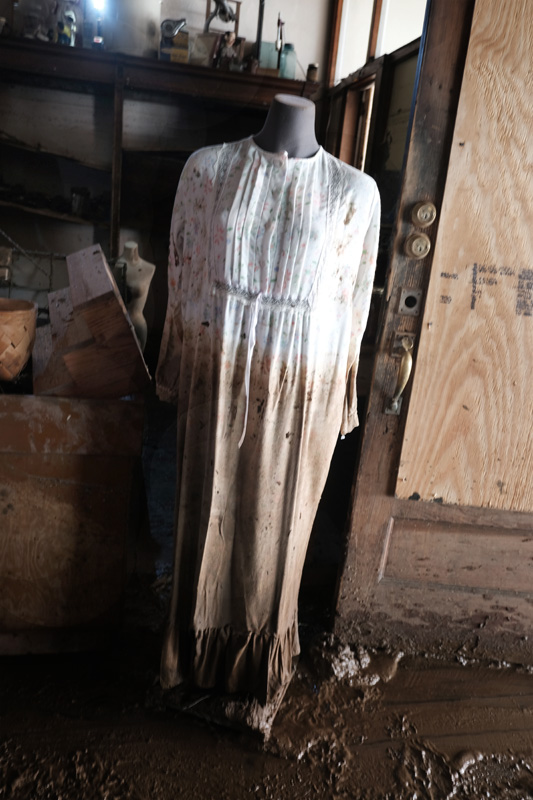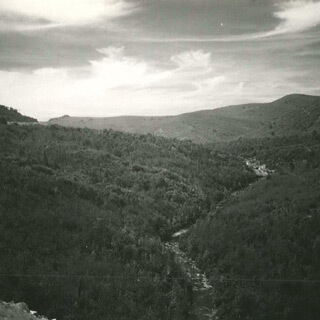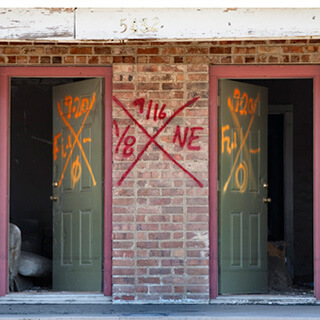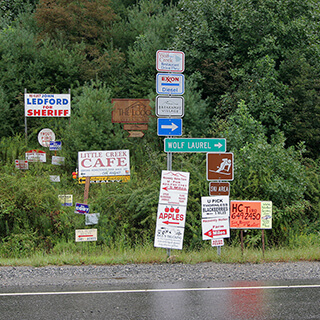Overview
Historian Maia A. Surdam considers the long career of documentary photographer and writer Rob Amberg. The essay centers on Amberg's recent book, Little Worlds (2024) the culmination of his trilogy of work that reveals the "texture and feeling of life" within his home of Madison County, North Carolina. All photos copyright © Rob Amberg and used by permission.
The first photograph that Rob Amberg ever made in Madison County, North Carolina shows a barn with a large ominous message painted on its side. “Get Right With God,” it warned. Back in 1974, when Amberg was a newcomer to the Appalachian mountains and drove past the structure often, its “fundamentalist and apocalyptic tone” made him “wonder if [he’d] chosen the right place to live.” The barn no longer stands, but its story remains a symbol of Amberg’s complicated relationship with this place that has changed dramatically in the fifty years that he has lived here and documented it. As he describes in his most recent book, Little Worlds, long after the barn came down, its message took on a different meaning for him, still dark with a “certain ‘or else’ undercurrent,” but more nuanced and personal. “‘I’ve come to accept and appreciate that message,” he says. “But I interpret it to mean being at peace with oneself and one’s own notion of God. As I look back at the stories and images of this life I’ve created, I might ask, ‘Am I ‘Right with God’? Did I live righteously? And what of the world itself? What went wrong and brought society to the point of collapse? Were we not right with God?”1Rob Amberg, Little Worlds (Marshall, North Carolina: RobbieBooks, 2024), 7-9.
Renowned documentary photographer Rob Amberg presents in Little Worlds an inventive and utterly immersive portrait of a place, the last in a trilogy that feature his longtime home. An expansive, rural, and dramatically beautiful locale buttressed in the mountains of southern Appalachia, Madison County sits just thirty miles north of cosmopolitan Asheville, but retains a feeling of being slightly wild, even after decades of change have brought more infrastructure, modern technology, and newcomers, like myself, into its fold. Amberg traded his middle-class, suburban upbringing in D.C. for the allure of a life lived closer to the land, however difficult, uncertain, and foreign it may have seemed upon his arrival in 1973. The place enthralled him. So did the people. Two years after moving to the mountains, Amberg met Dellie Norton, a tobacco-growing, ballad-singing woman with deep ties to the area and a friendly curiosity for outsiders. That fortuitous meeting grew into a long-lasting friendship and set Amberg on a course of documenting the people and places of Madison County that he has continued, diligently.
We learn about Amberg’s introduction into Madison County in his first book, Sodom Laurel Album (2002). “Photographs can teach us to look at the very texture and feeling of life around us,” he writes and then skillfully reveals.2Rob Amberg, Sodom Laurel Album (Chapel Hill: University of North Carolina Press, 2002), xii. Through intimate photographs of Dellie, her family and neighbors, as well as the land she tended, Amberg portrays a people and a way of life awash in riptide of change. In the twenty-five years between the beginning of that project to the time it was published, most people of Dellie’s generation had passed on. People in Madison County, for the most part, no longer grew tobacco, milked cows, or gathered at country stores to socialize. Yet plenty continued to sing ballads, play instruments, and raise gardens. The culture that Dellie Norton represents, Amberg claims, “has not so much vanished as continued to evolve in new and unexpected ways.”3Rob Amberg, Sodom Laurel Album, xxii.
Amberg offers a complex depiction of Sodom Laurel and Madison County, an approach that, he admits, also evolved over time. Initially he was intrigued by the old-timers exclusively, people whose connection to the land seemed stoic and stubbornly rooted in the past. Newcomers, many former suburbanites like himself, did not interest him. Nor did he want to depict anything negative he witnessed, for fear that he would perpetuate well-worn tropes of dangerous or deranged holler-dwellers. Once he came to know Dellie Norton and her broader community more intimately, his own “preconceptions …about romantic mountaineers” faded away, and he began to tell stories of real people and places that hold lightness and darkness simultaneously, an approach that remains consistent throughout all of his work.4Rob Amberg, Sodom Laurel Album, xx.
In Sodom Laurel Album, for instance, we see an especially disturbing photograph that Amberg made during a Ku Klux Klan meeting in 1976. Madison County was—and remains—a strikingly white place, and this image depicts a subset of the community that sought to keep it that way. Although the Klan did not have a lot of success in the mountains, Amberg learned, they occasionally held recruitment rallies, like one where a group of children appear in the center of the frame as the sought-after recruits. When Amberg shared his experience with Dellie Norton, she responded, ‘That’s them damn Rebels, ain’’t it?’ and followed up with a story about how her own grandmother’s life had been threatened, and her uncle’s life taken, by some Rebels years before because of their Unionist affiliations.
Norton’s reaction reveals one of the many divisions that existed within the cultural terrain of Madison County, which linger into the present day. Just a few months ago, for example, I encountered the twisted legacy of the Klan in conversation with a community member whose family has deep roots to this place. He shared that his grandfather had been a Wizard in the local chapter, but believed that his ancestor’s mission was fueled less by racism than by a desire to uphold American values and protect their women. I wonder how Dellie Norton, or her grandmother who dodged the Rebels’ bullets, would have responded to his interpretation, which manages to erase both violence perpetrated against women as well as animosity directed toward racial minorities. Amberg’s decision to include the photograph, however shameful it may have been to some of his contemporaries who held more egalitarian views, portrays Madison County as a place where some condone violence, or the threat of it, to preserve whiteness as the norm. At the same time, through the accompanying stories about Dellie Norton, he reveals two competing mentalities that he saw co-existing within the culture: fear of the racialized "other" and curiosity toward the incoming "outsider."
In Amberg’s second book, The New Road (2009), he continues to explore the complexity of place by delving deeper into themes of transformation and progress. What imprints are left when a mountain is pummeled to build an interstate highway, he asks. At this point in Amberg’s life, he had lived in Madison County for over three decades and had become embedded there. He was one of the residents, not simply an observer making photographs of it. The images and stories within the book depend upon his connections and the trust he had developed with neighbors. He interviewed more than thirty people about their opinions of the I-26 corridor that cut through their county, exposing complicated feelings and contradictory implications of development. Through Amberg’s images, we see a governor, a beauty queen, and a group of veterans celebrate the highway upon its completion at a new Visitor’s Center, hopeful for the convenience and access that will accompany it. We also learn of Howard and Lucille Babbitt, an elderly couple, who pick apples from their old family orchard for the last time before it is bulldozed to make room for the road. In perhaps the most heartbreaking photo of the book, JD Thomas walks away from the house where he was raised, his eyes gazing downward as flames engulf the old structure. “Bye, bye, old home place,” Amberg heard him utter.5Rob Amberg, The New Road (Chicago: Center for American Places at Columbia College, 2009), 31.

The New Road ends with Amberg’s own nuanced, yet ultimately troubled perspective of the changes he had witnessed over the decades: “all in all, Madison County has been able to find and maintain an acceptable balance between old and new….But some of what has come in the highway’s wake—the gated communities, the steep-slope development, the loss of wildness, the acres of land being bulldozed and paved, and the speed with which these things are happening—are real and symbolic evidence of a massive upheaval in our community. For me, they link us to the wider world I chose to leave behind years ago, and they are representative of a place out of balance.”6Amberg, The New Road, 175.
Fifteen years later, in Little Worlds, Amberg considers what the future may hold for a place unsteadied by perpetual growth, divided by fears (real and imagined), and occasionally ravaged by natural disasters. The book is a tribute to a life lived in a region in flux. It is a colorful collage of stories layered one over another, distinct moments of time feeding into each other, leading one to wonder where the lines between reality and fiction, or past and present, reside. Its structure follows Amberg’s previous works in its reliance on the interplay of words and images to tell a rich tale about a complicated place. But, otherwise, it takes a different approach. As Amberg told me, “I really wanted to break out of the documentary model…to break completely away from any pretense of objectivity.”7Amberg interview with Maia Surdam, March 13, 2025. He succeeds.
The storyteller’s imprint is everywhere. Amberg includes decades-old journal entries, filled with recollections of his daily life; there are vulnerable memories of divorce, remarriage, and building a life with his second wife Leslie; we see his son and daughter’s childhood photographs. Even the fictional story woven throughout was fashioned from a tale he once told his daughter Kate as part of their bedtime ritual. And, in one of the most touching final scenes I have encountered in a book, Rob Amberg depicts his future death. He has chosen a peaceful place for himself—under a shady tree in the Lost Cove, “holding [a] box of stories and memories close,” gazing at the night sky and listening for the sounds of an owl in the darkness.8Amberg, Little Worlds, 174. More than a photography book, it is a dramatic culmination of Amberg’s long-term commitment to document Madison County with insight, specificity, and imagination.
Though Little Worlds completes Amberg’s trilogy, it stands firmly on its own, offering contributions to multiple genres. History lovers, especially those of us interested in the transformation of rural life, have much to learn from Amberg’s recollections of fifty years of life in Appalachia. His work at the Rural Advancement Fund, which allowed him to travel throughout and document the rural South in the ‘80s, gave him a greater understanding of these complex changes. We feel the emotional blow of losing one’s farm when we look at his powerful photograph of a farmer holding a painting of an old farmhouse during an estate auction. We sense the massive impact that the building of the Marshall bypass had on one community’s social and spatial customs. We consider the innovation of rural people who repurpose old buildings in new ways, giving inspiration to those trying to remake small towns suited to the twenty-first century. And we see the risk of a fractured society when newcomers isolate themselves from local residents or culture, whether out of fear, indifference, or false assumptions of superiority.

Students of visual art will appreciate how Amberg continues to use photography to convey the “texture and feeling of life.” Landscape photos signify Madison County as Appalachian, yet evoke a different scale of time. A two-track road disappearing into a foggy mountain curve. A soft green valley, edged with trees and textured with the interplay of light and shadow. A thick forest blanketed with snow, peaceful and cold. We see moments of people’s daily lives that reveal the vitality of the human existence, no matter how ordinary. Dancers stomp their feet as fiddlers strum their bows. Young, hungry party-goers pull pieces of meat from a roasted hog. A woman proudly displays her jar of canned vegetables, suggesting the great effort it took to bring forth this food.
Other photographs deliberately show the passage of time, like the portraits of his daughter, which begin each chapter and show her grow from an infant into a young woman. As Amberg explained to me, “I wanted to remind the viewer that this was a story I was telling Kate…And, number two…she was my muse for years and I’ve got all these incredible photographs of her.”9Amberg interview with Maia Surdam, March 13, 2025.We sense, then, not only the evolution of a daughter listening to a bedtime story, but the changing seasons of an artist who has found creative freedom in the latter part of his career to include photographs that reveal tender moments of his parental journey. In this way, Little Worlds feels like a family heirloom, a loving gift from father to child, a collection of poignant photos and cherished memories.
As a writer and storyteller, Amberg ambitiously ventures into the realm of fiction, but this is no ordinary bedtime story. Readers will find interspersed in Little Worlds a compelling tale set in a dystopian future, reminiscent of Cormac McCarthy’s The Road or Octavia Butler’s Parable of the Sower. In this imagined world, Amberg’s descendants seek refuge in a place similar to Dellie Norton’s early days, both physically and socially, when people walked across dense mountains on foot and neighbors worked the land together out of necessity. With much of the world plagued by urban violence, incessant climate disasters, and systemic social decay, the characters in Amberg’s story, a blend of old-timers and newcomers, look to the past to build a better future in the mountains. They have a lot to learn.
Amberg includes a plethora of images that counter the familial ones of his daughter, and, at first glance, appear as disturbing as the chilling future he imagines. We see children playing with knives, a bow and arrow, and guns, à la Lord of the Flies. We see an animal skull attached to a pickup truck. We see a rebel flag displayed prominently on Main Street; a spooky religious figure surrounded by antlers; a row of disembodied squirrel tales hanging on a wall; and a bench lined with bloody sheep heads. Surely, the stories behind these individual photos would reveal details that forgo a simple, dire understanding (animals must be slaughtered before they are consumed, of course) but, collectively, they acknowledge the “hard and harsh” aspects of Madison County. Or, as he observed in his first book, “the meanness of the place was hard to ignore.”10Amberg, Sodom Laurel Album, 35.
In a clever narrative move, Amberg inserts himself within the fictional tale by having his imaginary descendants, Frank and Wright, discover a trunk of his writings and photographs inside their abandoned ancestral homeplace. In their search for peace and stability, the trunk and its precious contents provide evidence of the society that had existed before their world fell into chaos. To readers, these contents are Amberg’s personal memoirs and documentation of life in Madison County that spans over fifty years, with some overlap of what we have seen in his previous two books. To Frank and Wright, they are a treasure map that helps them connect a distant past, filled with its own set of challenges, to a future that might still be salvageable from their dismal present. Up until that point, their lives had been plagued by fear, distrust, and isolation. Environmental disaster, especially floods and wildfires, made life more uncertain. Perpetual migration became an act of survival for most. Within the time capsule left by their ancestor, they consider a different path forward. They see photographs of handmade quilts made for newborn babies. There is evidence of a vibrant social life, where people gathered for parties, town hall meetings, rodeos, and even something called a Mermaid Parade. Many photographs show people working on their land to produce food to eat, supplies to use, or commodities to trade. Their initial reaction to the trunk, and its stories of a functional community rooted in place, is hopeful.
Later in the story, as the numbers of refugees grow and the community becomes more racially and culturally diverse, tensions rise as well. The characters grapple with humanity’s shadowy sides. “There are those among us holding onto the past, as divisive as that old world had been,” one person observes. “They want to exclude those different from themselves and have threatened violence if they don’t get their way.”11Amberg, Little Worlds, 165. By weaving together fictional and historical storylines—and photos that range from beautiful to ordinary to provocative to downright unsettling—Amberg once again rejects notions of a romanticized Appalachian past where everyone lived in harmony. Through his personal entries, Amberg’s descendants learn that divisiveness and violence had been a consistent part of the landscape. “In Madison County,” Amberg writes, “the divides have always been sharp, but they’ve mostly stayed beneath the surface.”12Amberg, Little Worlds, 164. As the fictional settlers consider how to respond to ruptures in their new community, Amberg’s memoir laments the virulent political culture that is taking root in his longstanding one, especially with the rise of the first Trump presidency. With a president that explicitly “encourag[es] violence and anger,” old norms of civility seem to be rotting away on the local level too. “Neighbors—people I’ve known and liked for forty years are suddenly distant and angry. It’s as if my outsider status and points of view make me an enemy.”13Amberg, Little Worlds, 164.

The narrative arc in Little Worlds is a circuitous one, as the story ends close to where it begins, with the revelation of Amberg’s trunk and documentary contents. The experience of reading this book feels appropriate for our times. It is bewildering. Are we looking backward or forward? Where are the lines between reality and fiction? Madison County, like many rural places in the US, remains mostly, but not entirely, white, a demographic fact reflected in Amberg’s visual record. Today, there are few Black people living here, around 1% of the population, but there is a rising population of Latino immigrants, as well as more people who identify as bi- or multi-racial.14Around 3.5% of the county's population identifies as Latino or Hispanic, and 5% as “two or more races.” https://data.census.gov/profile/Madison_County,_North_Carolina?g=050XX00US37115#race-and-ethnicity Politically, this county votes predominantly, but not entirely, Republican, thus supporting the fear-based ideology of Trump that feeds on division, champions a narrative of white superiority, and enacts policies that are anti-immigrant.15For a decades’ long perspective on the shifting political climate of the western North Carolina county of Transylvania, see Dan T. Carter, “Good-Bye to All That,” Southern Spaces, December 19, 2014. And like the Madison County we glimpsed in Amberg’s earlier works, we continue to witness contradictory reactions by those in the racial majority, with anti-"other" fears and animosity (with threats of ICE raids targeting Latinos as the most alarming example), as well as acts of neighborly benevolence. As far as our physical environment, which has seen dramatic transformation due to direct and indirect human interventions, including the recent climate-change-related disaster, Hurricane Helene16See Amberg’s “Hurricane Helene Visits Marshall, North Carolina,”August 11, 2025.,we are grappling with questions of how to rebuild. In the immediate wake of natural disasters, divisions may fade in lieu of pressing needs for collective survival. But how can we remake ravaged places that will sustain us in the long run if we live divided from our neighbors, whether out of custom, ignorance, or fear? How do we heed lessons from the past without being tethered to its stubborn foundation of inequality and extraction? Though Little Worlds does not answer these questions, it extends them for our contemplation as we move toward the future.

Amberg’s personal narrative is winding, too, and somewhat ambivalent. He has journeyed from outside observer to resident photographer to “an enemy” among neighbors to a man digging his imaginary grave in the beloved mountains he calls home. As he explains it, Little Worlds “spelled a story of me moving here, being here, becoming part of this place [and] leaving my own footprint here…But recognizing at the same time that I really ain’t from around here.”17Amberg interview with Maia Surdam, July 12, 2025. His is an uneasy position, but one that he occupies bravely and honestly. Little Worlds is an expansive rendering that portrays a multidimensional place where various, opposing elements coexist, however uncomfortably. As such, his story presents no clear directions on how to avoid the catastrophic future he imagines. What Amberg does give is the insight that thriving societies must cultivate vulnerability among its people. As he models for us, we must courageously share our stories, in their most truthful forms, however ambiguous, and graciously receive and reflect on those shared by others. This lesson is part of Rob Amberg’s legacy, applicable to us all, no matter what little worlds we inhabit. 
About the Author
Maia A. Surdam earned a Ph.D. in US History from the University of Wisconsin-Madison. An independent scholar of underrepresented histories of rural America, she recently contributed essays to Affrilachia: Testimonies (University Press of Kentucky, 2024). Surdam resides in the mountains of western North Carolina and serves as the Programs Director for Partnership for Appalachian Girls' Education (PAGE).
Banner image: Carnival on the Island, Marshall, 1983. All photos copyright © Rob Amberg and used by permission.
Recommended Resources
Books
Amberg, Rob. Sodom Laurel Album. Chapel Hill: University of North Carolina Press, 2002.
___________. Quartet: Four North Carolina Photographers. New London: Safe Harbor Books, 2005.
___________. The New Road. Chicago: Center for American Places at Columbia College, 2009.
___________. Little Worlds. Marshall, North Carolina: RobbieBooks, 2024.
Web
Amberg, Rob. Sodom Laurel Album Explores North Carolina Mountain Community. Library of Congress Webcast, 2003.
http://www.loc.gov/today/cyberlc/feature_wdesc.php?rec=3312
___________. "Driving Through Time: The Digital Blue-Ridge Parkway," Southern Spaces, April 3, 2012. https://southernspaces.org/2012/driving-through-time-digital-blue-ridge-parkway/
___________. “Hurricane Helene Visits Marshall, North Carolina,” Southern Spaces, August 11, 2025. https://southernspaces.org/2025/hurricane-helene-visits-marshall-north-carolina/
Cohen, John. The End of an Old Song. Film.
https://www.folkstreams.net/films/end-of-an-old-song
King, Martha and Rob Roberts. Madison County Project: Documenting the Sound (2005).
http://www.folkstreams.net/film,120
Similar Publications
| 1. | Rob Amberg, Little Worlds (Marshall, North Carolina: RobbieBooks, 2024), 7-9. |
|---|---|
| 2. | Rob Amberg, Sodom Laurel Album (Chapel Hill: University of North Carolina Press, 2002), xii. |
| 3. | Rob Amberg, Sodom Laurel Album, xxii. |
| 4. | Rob Amberg, Sodom Laurel Album, xx. |
| 5. | Rob Amberg, The New Road (Chicago: Center for American Places at Columbia College, 2009), 31. |
| 6. | Amberg, The New Road, 175. |
| 7. | Amberg interview with Maia Surdam, March 13, 2025. |
| 8. | Amberg, Little Worlds, 174. |
| 9. | Amberg interview with Maia Surdam, March 13, 2025. |
| 10. | Amberg, Sodom Laurel Album, 35. |
| 11. | Amberg, Little Worlds, 165. |
| 12. | Amberg, Little Worlds, 164. |
| 13. | Amberg, Little Worlds, 164. |
| 14. | Around 3.5% of the county's population identifies as Latino or Hispanic, and 5% as “two or more races.” https://data.census.gov/profile/Madison_County,_North_Carolina?g=050XX00US37115#race-and-ethnicity |
| 15. | For a decades’ long perspective on the shifting political climate of the western North Carolina county of Transylvania, see Dan T. Carter, “Good-Bye to All That,” Southern Spaces, December 19, 2014. |
| 16. | See Amberg’s “Hurricane Helene Visits Marshall, North Carolina,”August 11, 2025. |
| 17. | Amberg interview with Maia Surdam, July 12, 2025. |









